Phylum Nematoda — Roundworms
Characteristics
- Body elongate, round in cross section, tapered at ends
- Unsegmented
- Complete gut
- Pseudocoelomate or acoelomate
- Widespread and abundant in all habitats; some parasitic
|
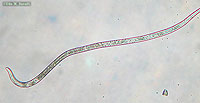
Vinegar Eel, Turbatrix aceti, a free-living nematode.
|
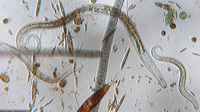
Free-living marine nematodes
|

Dog Hookworm, Ancylostoma caninum, female (stained whole mount)
|

Ascaris lumbricoides; stained cross-sections of female, male, and through pharynx.
See also labeled photo.
|
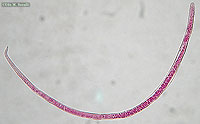
Adult female trichina worm, Trichinella spiralis (stained whole mount)
|
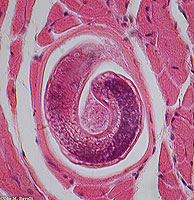
Encysted larva of trichina worm, Trichinella spiralis, in muscle tissue (Trichinosis); (stained whole mount).
|
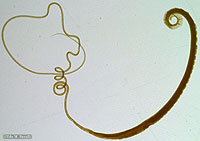
Whipworm, Trichuris sp., an intestinal parasite; (stained whole mount).
|
Unidentified marine nematode on a microscope slide placed in a salt-water aquarium (bright field, 10x objective lens)
|
|
Phylum Nematomorpha — Horsehair Worms
Characteristics
- Body greatly elongate, thread-like (up to 1 m long), often curled up and folded on itself
- Unsegmented
- Lack functional gut
- Pseudocoelomate
- Adults mostly in fresh water; larvae parasitic on insects
|
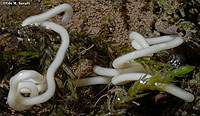
Horsehair Worm, Paragordius sp.?, KY
|
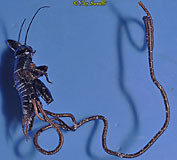
Horsehair worm emerging from its cricket host; preserved specimen
|
|
Phylum Priapulida — Penis Worms
Characteristics
- Fully retractable introvert that is covered in spines
- Chitinous cuticle that is molted
- Posterior end has branching caudal appendage, presumably for respiration
- Small, up to 20 cm long
- Benthic marine
See additional fossil worms here: scroll down for priapulid worms
|
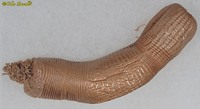
Dried penis worm, Priapulus sp.
|
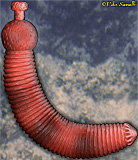
Model of penis worm, Ottoia sp.; Cambrian Period
|
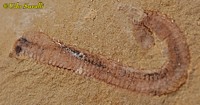
Fossil of Palaeoscolex sp., a probable stem-priapulid; Cambrian Period, China
|
|